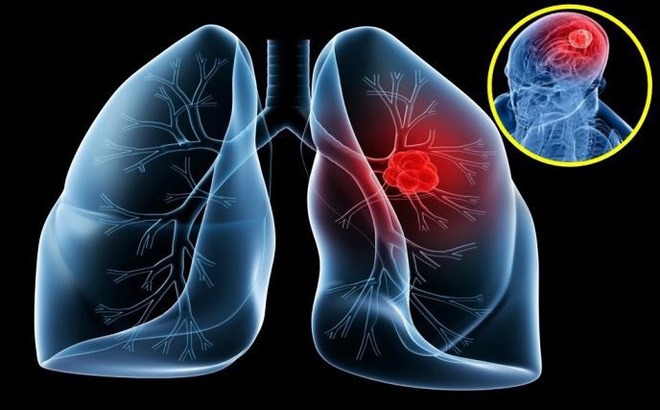Ms. D. had terminal lung cancer that had metastasized to her brain, bones, and other organs. Thanks to the discovery of a gene mutation, she was treated with targeted drugs, which helped her escape her critical condition and prolong her life.
Ms. D. had terminal lung cancer that had metastasized to her brain, bones, and other organs. Thanks to the discovery of a gene mutation, she was treated with targeted drugs, which helped her escape her critical condition and prolong her life.
Reviving lung cancer patients
At the end of January, 51-year-old CTND had a follow-up visit with Dr. Ngo Tuan Phuc, an oncologist, after 10 months of treatment for stage 4 non-small cell lung cancer.
At this time, Ms. D. has recovered strongly: she no longer has slurred speech, her mouth is no longer crooked, she eats normally, has gained 10 kg and is no longer completely exhausted, completely different from February 2024, when Ms. D. was rushed to the emergency room in critical condition.
 |
| Illustration photo. |
Recalling the time of hospitalization in February 2024, her relatives said she had difficulty speaking, blurred vision, swelling of the left hand and difficulty breathing, along with lung cancer metastasis.
MRI results showed multiple brain lesions, with the largest lesion in the left frontal lobe measuring 32x31mm, causing cerebral edema and compression of the left ventricle. This was the cause of Ms. D's neurological complications.
Dr. Phuc said that without timely treatment, Ms. D.'s risk of death would be very high. After consulting with the radiation oncologist, the doctor decided to treat the brain edema with internal medicine and perform a biopsy of the right cervical lymph node.
Genetic testing results showed that Ms. D. had an ALK gene mutation - a rare mutation in non-small cell lung cancer (accounting for 4.4% - 6.7%), often detected when there are brain metastases. For treatment, Ms. D. was prescribed targeted drugs that help block the ALK mutation and are highly effective in improving neurological symptoms.
After only 1 week of treatment, Ms. D. no longer had difficulty breathing, blurred vision, swelling of the left hand, and symptoms such as crooked mouth, slurred speech, and hemiplegia were also significantly reduced. Dr. Phuc assessed Ms. D.'s recovery as very positive and continued to prescribe targeted drugs combined with physical therapy to improve her condition.
Currently, after more than 10 months of treatment, the CT scan results of the lungs show that the tumor in the lungs has decreased in size and there are almost no traces left. However, the brain tumor shows signs of returning, and Ms. D. may need to undergo brain radiation therapy or continue treatment with new generation targeted drugs to prevent the progression of the disease.
Regarding the treatment process, in October 2023, Ms. D. went for a routine health check-up and discovered left pleural effusion. A CT scan showed a 3x3 cm lung tumor and a large amount of left pleural effusion causing lung collapse. After bronchoscopy and biopsy, the results confirmed lung cancer, adenocarcinoma.
Doctors had previously predicted that Ms. D. would only have 6 months to less than a year to live. However, thanks to early detection of genetic mutations and proper treatment, her chances of survival and prolonging her life have been significantly improved.
According to statistics from the Global Cancer Organization (Globocan), lung cancer ranks second among the most common cancers in both men and women in Vietnam.
Lung cancer is divided into two main types: small cell lung cancer and non-small cell lung cancer. Non-small cell lung cancer accounts for about 80% of lung cancer cases, like Ms. D's case.
Dr. Phuc explained that cancer is the result of changes in genes that control cell growth. These gene mutations are often caused by environmental factors such as chemicals, UV rays, bacteria, or errors in the cell's DNA replication process. The discovery of gene mutations in non-small cell lung cancer has created a new treatment method that "locks" the mutations and prevents tumor growth.
Targeted therapy opens a new era in the treatment of advanced non-small cell lung cancer, helping to prolong survival and improve the quality of life of patients.
However, the drug is expensive, making it difficult for many patients to access. However, with the development of modern medicine, doctors expect to discover more gene mutations and provide effective treatments, while reducing drug costs to expand treatment opportunities for patients.
Girl with dilated heart chambers due to complications of atrial septal defect
The intervention for Truc, 11 months old, was complicated because the baby was underweight, had a large atrial septal defect, and there was a risk of heart valve damage if an umbrella was too large.
According to doctors, atrial septal defect is a congenital heart disease with the appearance of a hole between the two atria (upper chambers of the heart). A small atrial septal defect (less than 5 mm) can close on its own.
Larger holes that are asymptomatic and do not cause health problems do not require surgery when the child is young, but must be monitored and may require intervention when the child is older. In cases where complications such as right heart dilation or slow weight gain or heart failure have occurred, timely intervention is needed.
Baby Truc was born full-term, weighing nearly 3.8 kg at birth. Her mother said that no one in her family had heart disease, and no abnormalities were detected during her pregnancy. When the baby was two months old, she went for vaccinations and had a general check-up and heard a heart murmur.
This is a sound caused by uneven blood flow in or near the heart, suggesting some cardiovascular diseases. The family took the baby for an echocardiogram, which recorded a large atrial septal defect, measuring 11 mm with no complications. The doctor did not prescribe closure of the defect, and scheduled a follow-up visit for regular monitoring.
Six months later, Truc showed signs of slow weight gain, and some months even lost a little weight. She often had recurrent respiratory infections and ate poorly. At the follow-up examination at 11 months old, an echocardiogram revealed that her right heart chamber had become enlarged, which had progressed compared to the previous examination.
“The combination of symptoms and echocardiogram shows that the atrial septal defect has caused complications, requiring early parachute intervention to close the defect,” Dr. Thuy said.
Dr. Vu Nang Phuc, who directly treated the patient, assessed that this intervention was quite complicated because Truc was underweight (8.4 kg at the time of intervention), and her hole was more than 10 mm, so a large umbrella was needed to completely close it.
However, in underweight children, if the parachute is too large, it can easily compress the surrounding organs, causing mitral valve regurgitation or tricuspid valve regurgitation. In addition, the small right atrium dilates, making the left atrium smaller, making it difficult to operate due to the narrow space of the heart chamber, making it difficult to deploy the parachute and accurately seal the hole.
To fix the problem, Dr. Phuc and his team tried to use the smallest parachute (12 mm in diameter) to completely block the hole without damaging the heart valve. Throughout the intervention, X-ray images and transesophageal echocardiography were guided, helping the doctor perform the procedure accurately. After 45 minutes, the procedure was successfully completed.
Post-intervention echocardiography showed that the hole was sealed and did not compress surrounding structures. The baby was discharged one day after the intervention.
According to Dr. Phuc, parachute closure of atrial septal defect is the first choice for cases of atrial septal defect with suitable anatomical structure. This is a minimally invasive intervention method with many advantages such as safety, less blood loss, less pain, reduced risk of infection, quick recovery time, no chest opening so no scarring.
Children can resume normal activities immediately after the intervention. If the hole is successfully closed and post-intervention care is good, the child will fully recover and develop like a normal child.
Congenital heart disease can be prevented to some extent by getting vaccinated against Rubella (German measles), avoiding taking medication not prescribed by a doctor during the first three months of pregnancy, and avoiding alcohol and drug use during pregnancy...
Compared to other congenital heart diseases, atrial septal defect is often diagnosed later. Doctor Thuy said that Truc was detected early because she had early symptoms due to the large hole.
If the child is pale, sweats a lot, has cold hands and feet, slow weight gain, rapid breathing, wheezing, or recurrent respiratory infections, parents should take their child to a specialized medical facility for congenital heart disease screening.
Headache, insomnia, loss of appetite due to fatty liver due to being overweight
Ms. LPH is 36 years old, an office worker for an import-export company. Her job is mainly data entry, she has to sit in front of the computer for 6-7 hours a day, so although she is only 1m55 tall, her body is quite "plump" with a weight of about 76 kg.
Although she knew she was overweight, due to her busy work schedule and lack of time, and seeing that her health was still normal, she only limited starch and ate less without following any weight loss plan.
Occasionally she felt pain and discomfort in the upper right abdomen, sometimes lost her appetite, and recently had headaches and insomnia. At the end of the year, during a routine health check-up at the company, an abdominal ultrasound showed that she had grade 2 fatty liver.
By chance, she met an old classmate who told her about his treatment to reduce visceral fat after discovering grade 2 fatty liver. “That was when I learned that if fatty liver is not treated, it can progress to hepatitis, cirrhosis, and even liver cancer,” Ms. H. said and decided to go for a more thorough check-up.
InBody measurement results showed that she had a BMI of 31.6 (kg/m²), grade 2 obesity; visceral fat level of 162 cm² (average level below 100 cm²), within the threshold of bad visceral fat.
The amount of fat accumulated in the liver alone accounts for nearly 20% of the total liver weight - meaning grade 2 fatty liver. The doctor explained that excessive weight gain and excess visceral fat increased the risk and severity of Ms. H's fatty liver.
Specialist Doctor 2 Truong Thi Vanh Khuyen, Tam Anh Weight Loss Center said, in this case, level 2 fatty liver is the cause of the patient's fatigue, stomachache, headache, and difficulty sleeping.
If fatty liver persists and is not well controlled, it can cause liver function to decline and become damaged, leading to cirrhosis, hepatitis, and even liver cancer.
The higher the weight, the greater the amount of visceral fat accumulated, leading to the risk of a series of diseases such as fatty liver, diabetes, high blood pressure, and stroke.
Accumulated visceral fat can affect the arteries, increasing the pressure on the cardiovascular system. This increases the risk of heart attack, stroke and other vascular problems such as insomnia, headaches, memory loss.
When the liver is fatty, it cannot function effectively in metabolizing and removing toxins from the body. This leads to toxins accumulating in the body, causing fatigue, headaches, and affecting sleep quality.
On the other hand, fatty liver affects the metabolism of nutrients, especially lipids and sugars, leading to hormonal and energy imbalances in the body. This can cause fatigue, loss of appetite, headaches, etc.
Ms. H. was given a treatment plan by the doctor to reduce body fat using oral and injectable medications, combined with a diet and exercise regimen appropriate to her work and lifestyle. After a follow-up visit after 2 months, although the treatment regimen had not yet been completed, her visceral fat was almost at a safe level, and her fatty liver had also decreased to only level 1.
According to Dr. Vanh Khuyen, normally, a healthy liver will have about 3% - 5% of its weight as fat. Fatty liver is a condition in which the amount of fat accumulated in the liver exceeds 5% of the liver's weight. Using ultrasound, based on the phenomenon of increased brightness of liver parenchyma on the image, the doctor can determine the level of fatty liver.
For an accurate assessment, patients should do more in-depth tests such as blood tests, liver function tests, and more accurate imaging methods such as CT scans, MRIs, InBody measurements, etc. to determine the level of fat in the liver as well as the amount of visceral fat in the body.
Dr. Khuyen explains that when you eat too many foods rich in calories and carbohydrates, your body can develop insulin resistance. Insulin resistance affects the regulation of blood sugar, causing the liver to produce too much glucose (sugar).
As a result, the liver converts excess glucose into fat and stores it in liver cells, causing fatty liver. This is a condition called non-alcoholic fatty liver disease. In turn, fatty liver also causes and worsens insulin resistance, leading to a “vicious cycle”.
Therefore, weight loss is the “key” to controlling and treating fatty liver. “Just losing about 5%-10% of body weight can help reduce liver fat, improve insulin resistance, reduce inflammation, metabolize lipids better and improve liver function,” Dr. Khuyen explained.
However, not only overweight and obese people have fatty liver. Doctor Khuyen said that people with normal weight but unhealthy diet and lifestyle, the body does not have enough nutrients leading to low blood sugar, increasing the breakdown of fat into energy.
This increases the amount of fatty acids entering the blood, leading to fat accumulation in the liver. If you are lazy, fat will accumulate in the liver and not be metabolized, which can lead to fatty liver over time.
Doctors recommend that when going for a health check-up, if the abdominal ultrasound results show fatty liver, the patient should go for a specialist examination.
“Currently, the most accurate, simple, and inexpensive way to determine visceral fat is to measure InBody. Depending on each person's visceral fat level, the doctor will give appropriate advice and treatment instructions,” said Dr. Khuyen.
Source: https://baodautu.vn/tin-moi-y-te-ngay-142-hoi-sinh-nguoi-benh-mac-ung-thu-phoi-d246348.html




















































![[Maritime News] More than 80% of global container shipping capacity is in the hands of MSC and major shipping alliances](https://vphoto.vietnam.vn/thumb/402x226/vietnam/resource/IMAGE/2025/7/16/6b4d586c984b4cbf8c5680352b9eaeb0)













































Comment (0)